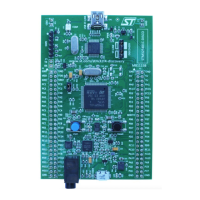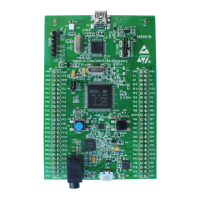USB on-the-go full-speed (OTG_FS) RM0402
984/1163 RM0402 Rev 6
The end of periodic frame interrupt (OTG_GINTSTS/EOPF) is used to notify the application
when 80%, 85%, 90% or 95% of the time frame interval elapsed depending on the periodic
frame interval field in the device configuration register (PFIVL bit in OTG_DCFG). This
feature can be used to determine if all of the isochronous traffic for that frame is complete.
29.9 OTG_FS low-power modes
Table 200 below defines the STM32 low power modes and their compatibility with the OTG.
The following bits and procedures reduce power consumption.
The power consumption of the OTG PHY is controlled by two or three bits in the general
core configuration register, depending on OTG revision supported.
• PHY power down (OTG_GCCFG/PWRDWN)
It switches on/off the full-speed transceiver module of the PHY. It must be preliminarily
set to allow any USB operation
• V
BUS
detection enable (OTG_GCCFG/VBDEN)
It switches on/off the V
BUS
sensing comparators associated with OTG operations
Power reduction techniques are available while in the USB suspended state, when the USB
session is not yet valid or the device is disconnected.
• Stop PHY clock (STPPCLK bit in OTG_PCGCCTL)
When setting the stop PHY clock bit in the clock gating control register, most of the
48 MHz clock domain internal to the OTG core is switched off by clock gating. The
dynamic power consumption due to the USB clock switching activity is cut even if the
48 MHz clock input is kept running by the application
Most of the transceiver is also disabled, and only the part in charge of detecting the
asynchronous resume or remote wakeup event is kept alive.
• Gate HCLK (GATEHCLK bit in OTG_PCGCCTL)
When setting the Gate HCLK bit in the clock gating control register, most of the system
clock domain internal to the OTG_FS core is switched off by clock gating. Only the
register read and write interface is kept alive. The dynamic power consumption due to
Table 200. Compatibility of STM32 low power modes with the OTG
Mode Description USB compatibility
Run MCU fully active
Required when USB not in
suspend state.
Sleep
USB suspend exit causes the device to exit Sleep mode. Peripheral
registers content is kept.
Available while USB is in
suspend state.
Stop
USB suspend exit causes the device to exit Stop mode. Peripheral
registers content is kept
(1)
.
Available while USB is in
suspend state.
Standby
Powered-down. The peripheral must be reinitialized after exiting
Standby mode.
Not compatible with USB
applications.
1. Within Stop mode there are different possible settings. Some restrictions may also exist, please refer to Section 5: Power
controller (PWR) to understand which (if any) restrictions apply when using OTG.

